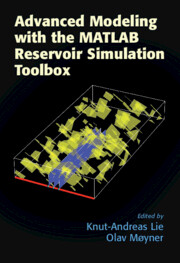Book contents
- Frontmatter
- Contents
- List of Contributors
- Preface
- Acknowledgments
- Navigating the Book and the MRST Modules
- Part I Grid Generation, Discretizations, and Solvers
- Part II Rapid Prototyping and Accelerated Computation
- Part III Modeling of New Physical Processes
- 7 Using State Functions and MRST’ls AD-OO Framework to Implement Simulators for Chemical EOR
- 8 Compositional Simulation with the AD-OO Framework
- 9 Embedded Discrete Fracture Models
- 10 Numerical Modeling of Fractured Unconventional Oil
- 11 A Unified Framework for Flow Simulation in Fractured Reservoirs
- 12 Simulation of Geothermal Systems Using MRST
- 13 A Finite-Volume-Based Module for Unsaturated Poroelasticity
7 - Using State Functions and MRST’ls AD-OO Framework to Implement Simulators for Chemical EOR
from Part III - Modeling of New Physical Processes
Published online by Cambridge University Press: 20 November 2021
- Frontmatter
- Contents
- List of Contributors
- Preface
- Acknowledgments
- Navigating the Book and the MRST Modules
- Part I Grid Generation, Discretizations, and Solvers
- Part II Rapid Prototyping and Accelerated Computation
- Part III Modeling of New Physical Processes
- 7 Using State Functions and MRST’ls AD-OO Framework to Implement Simulators for Chemical EOR
- 8 Compositional Simulation with the AD-OO Framework
- 9 Embedded Discrete Fracture Models
- 10 Numerical Modeling of Fractured Unconventional Oil
- 11 A Unified Framework for Flow Simulation in Fractured Reservoirs
- 12 Simulation of Geothermal Systems Using MRST
- 13 A Finite-Volume-Based Module for Unsaturated Poroelasticity
Summary
Surfactant and polymer flooding, alone or in combination, are common and effective chemical EOR methods. This chapter reviews the main physical mechanisms and presents how the corresponding mathematical flow models are implemented as an add-on module to MRST to provide a powerful and flexible tool for investigating flooding processes in realistic reservoir scenarios. Using a so-called limited-compositional models, surfactant and polymer are both assumed to be transported in the water phase only, but also adsorbed within the rock. The hydrocarbon phases are described with the standard three-phase black-oil equations. The resulting flow models also take several physical effects into account, such as chemical adsorption, inaccessible pore space, permeability reduction, effective solution viscosities, capillary pressure alteration, relative permeability alteration, and so on. The new simulator is implemented using the object-oriented, automatic differentiation (AD-OO) framework from MRST, and can readily utilize features such as efficient iterative linear solvers with constrained pressure residual (CPR) preconditioners, efficient implicit and sequential solution strategies, advanced time-step controls, improved spatial discretizations, etc. We describe how the computation of fluid properties can be decomposed into state functions for better granularity and present several numerical examples that demonstrate the software and illustrate different physical effects. We also discuss the resolution of trailing chemical waves and validate our implementation against a commercial simulator.
Keywords
- Type
- Chapter
- Information
- Advanced Modeling with the MATLAB Reservoir Simulation Toolbox , pp. 257 - 323Publisher: Cambridge University PressPrint publication year: 2021
- Creative Commons
- This content is Open Access and distributed under the terms of the Creative Commons Attribution licence CC-BY-NC-ND 4.0 https://creativecommons.org/cclicenses/



